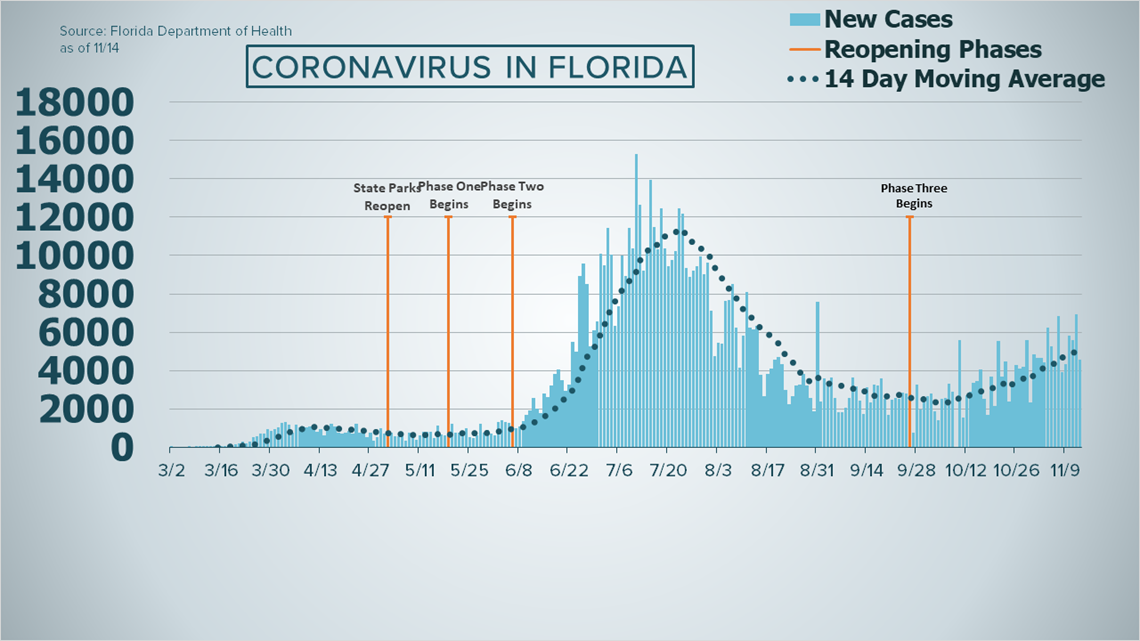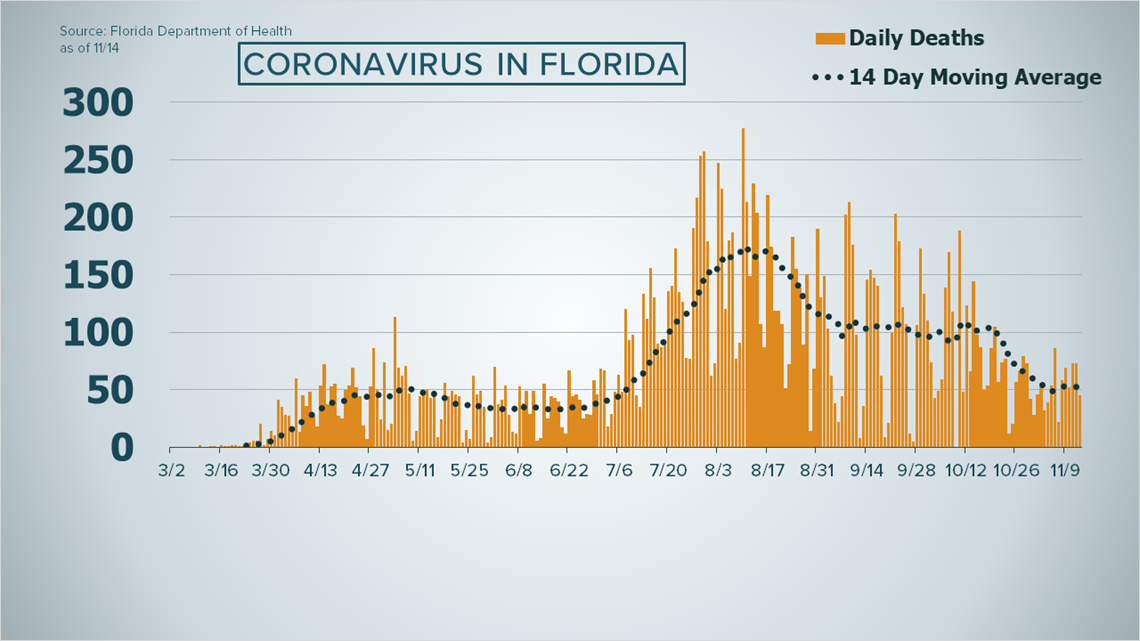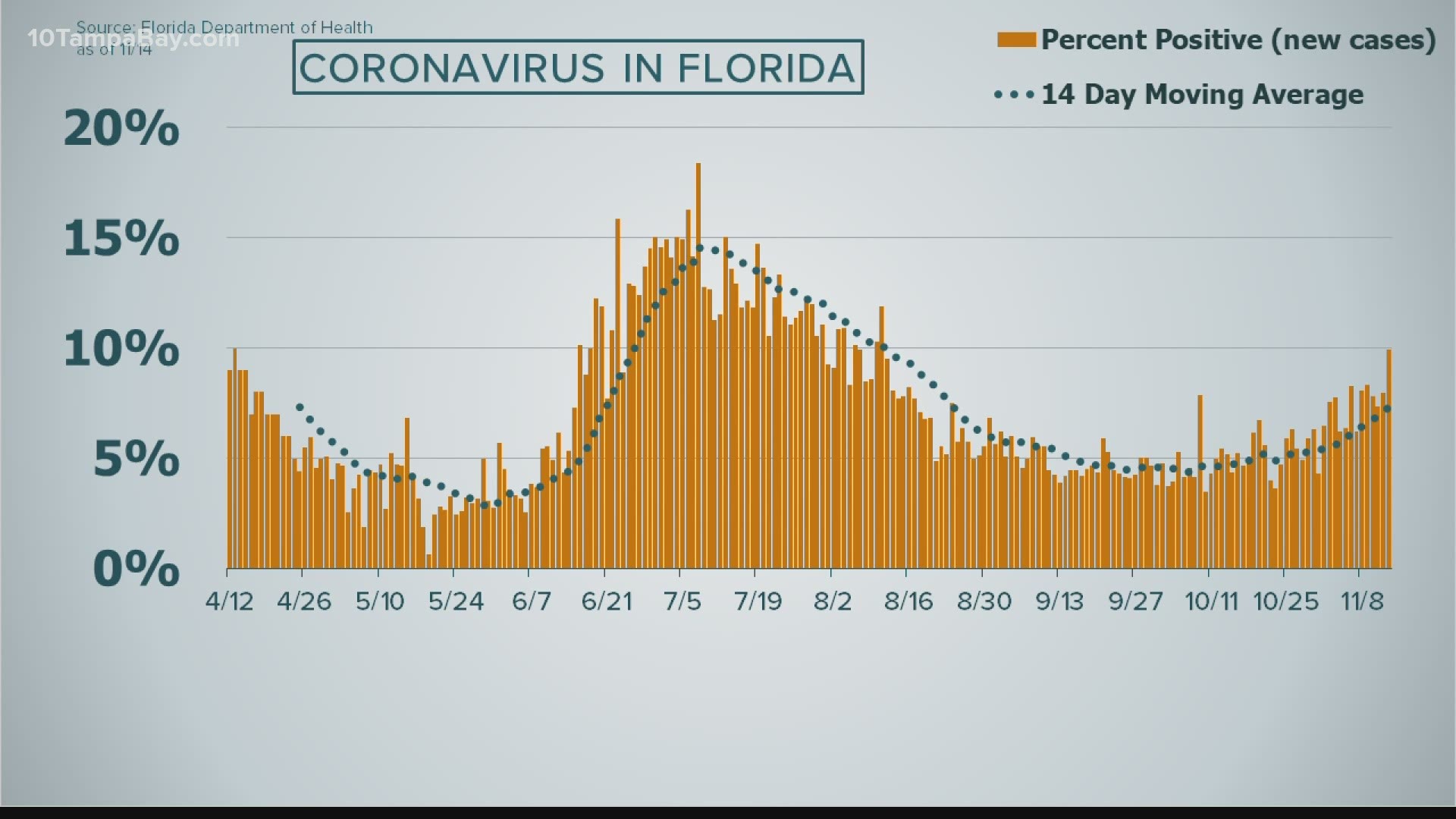ST. PETERSBURG, Fla. — Saturday's report from the Florida Department of Health showed the percent positivity for new COVID-19 cases in Florida residents reached a level not seen since mid-August.
There were 49,617 people tested on Nov. 13, with the percent of positive results at 9.95 percent. The percentage last neared this level around Aug. 10-12.
The positivity rate is one piece of data health experts analyze to determine how well an area is doing in combating the coronavirus and conducting tests. The World Health Organization has repeatedly said the percent positive should remain at 5 percent or lower for a 14-day span in order for further reopening to be recommended.
The state's latest report also showed an increase of 4,544 COVID-19 cases for the previous day. That brings the statewide total to 875,096 cases since tracking began in March.
Case increases in recent days have caused the statewide 14-day moving average to rise since the beginning of October. As a whole, the U.S. last week broke record after record of new coronavirus cases faster than the number of new tests taken, according to The COVID Tracking Project.
That is suggestive of an "uncontrolled spread of COVID-19," the group said.
The state also reported another 44 Floridians and one non-resident had died after testing positive for COVID-19. That brings the total to 17,489 residents and 215 non-residents who have died since the pandemic began -- a total of 17,704 deaths in the state.
Those numbers do not necessarily mean those people died Friday, but rather the state learned of their deaths and added the numbers to the report that day. The state's line-by-line report, which you can read here, lists coronavirus deaths by the date the people tested positive for the virus, not the date they passed.
The median age of Floridians testing positive is 40.
As for hospitalizations, 3,139 people in Florida were hospitalized with coronavirus as their primary diagnosis as of Saturday morning. Of those, 842 patients were in the Tampa Bay area.
Statewide, a total of 51,813 people in Florida have been hospitalized with the virus at some point during the pandemic.


Here's a breakdown of new coronavirus cases reported to the state:
- June 21: 2,926
- June 22: 3,286
- June 23: 5,508
- June 24: 5,004
- June 25: 8,942
- June 26: 9,585
- June 27: 8,530
- June 28: 5,266
- June 29: 6,093
- June 30: 6,563
- July 1: 10,109
- July 2: 9,488
- July 3: 11,458
- July 4: 10,059
- July 5: 6,336
- July 6: 7,347
- July 7: 9,989
- July 8: 8,935
- July 9: 11,433
- July 10: 10,360
- July 11: 15,300
- July 12: 12,624
- July 13: 9,194
- July 14: 10,181
- July 15: 13,965
- July 16: 11,466
- July 17: 10,328
- July 18: 12,478
- July 19: 10,347
- July 20: 9,440
- July 21: 9,785
- July 22: 10,249
- July 23: 12,444
- July 24: 12,199
- July 25: 9,344
- July 26: 8,892
- July 27: 9,230
- July 28: 9,446
- July 29: 9,956
- July 30: 8,989
- July 31: 9,643
- August 1: 7,104
- August 2: 4,752
- August 3: 5,446
- August 4: 5,409
- August 5: 7,650
- August 6: 7,686
- August 7: 8,502
- August 8: 6,229
- August 9: 4,155
- August 10: 5,831
- August 11: 8,109
- August 12: 6,236
- August 13: 6,148
- August 14: 6,352
- August 15: 3,779
- August 16: 2,678
- August 17: 3,838
- August 18: 4,115
- August 19: 4,555
- August 20: 4,684
- August 21: 4,311
- August 22: 2,974
- August 23: 2,258
- August 24: 2,673
- August 25: 3,220
- August 26: 3,269
- August 27: 3,815
- August 28: 3,197
- August 29: 2,583
- August 30: 1,885
- August 31: 7,569 (Quest Diagnostics backlog)*
- September 1: 2,402
- September 2: 3,571
- September 3: 3,198
- September 4: 3,656
- September 5: 2,564
- September 6: 1,838
- September 7: 1,823
- September 8: 2,056
- September 9: 2,583
- September 10: 3,650
- September 11: 3,190
- September 12: 2,423
- September 13: 1,736
- September 14: 3,116
- September 15: 2,355
- September 16: 3,255
- September 17: 3,204
- September 18: 3,573
- September 19: 2,521
- September 20: 1,685
- September 21: 2,470
- September 22: 2,590
- September 23: 2,541
- September 24: 2,847
- September 25: 2,795
- September 26: 1,882
- September 27: 738
- September 28: 3,266
- September 29: 1,948
- September 30: 2,628
- October 1: 2,660
- October 2: 2,811
- October 3: 1,868
- October 4: 1,415
- October 5: 2,241
- October 6: 2,582
- October 7: 3,306
- October 8: 2,908
- October 9: No daily report due to Dept. of Health technical issue*
- October 10: 5,570
- October 11: 1,533
- October 12: 2,725
- October 13: 2,883
- October 14: 3,356
- October 15: 3,449
- October 16: 4,044
- October 17: 2,539
- October 18: 1,707
- October 19: 3,662
- October 20: 2,145
- October 21: 5,557
- October 22: 3,689
- October 23: 4,471
- October 24: 2,385
- October 25: 3,377
- October 26: 4,298
- October 27: 4,115
- October 28: 4,198
- October 29: 5,592
- October 30: 2,331
- October 31: 4,865
- November 1: 4,651
- November 2: 4,637
- November 3: 4,423
- November 4: 6,257
- November 5: 5,245
- November 6: 4,452
- November 7: 6,820
- November 8: 3,924
- November 9: 4,353
- November 10: 5,838
- November 11: 5,607
- November 12: 6,933
- November 13: 4,544
Breaking down the numbers
For the month of August, daily reported COVID-19 cases in Florida remained under 10,000. And, for more than a week, daily new cases were under 4,000.
That changed with the report for Aug. 31. A backlog* of nearly 75,000 test results from Quest Diagnostics was added to that day's report, which resulted in 7,569 new cases reported. Failure to report those test results earlier, most of which were more than two weeks old, with some dating all the way back to April, caused the Department of Health to sever all ties with Quest, according to the state.
Florida on Oct. 30 became the third state to cross the 800,000 reported COVID-19 cases mark. As of Nov. 14, Texas and California reported more than 1 million cases, according to Johns Hopkins University & Medicine.
Since Sept. 1, daily reported COVID-19 cases had stayed below 4,000 until Oct. 16. Florida has not reported a single-day new case number at or higher than 10,000 since late July.
Data for Oct. 10 was not individually released because of a technical issue. The health department on Saturday said the error was because of a data dump of approximately 400,000 previously-reported test results from a private lab. The state clarified Tuesday that the error was a technical issue and not the fault of Helix Laboratory.
The state needed to de-duplicate hundreds of thousands of results, and the daily COVID-19 report resumed on Oct. 11.
The highest single-day case number Florida has reported so far is 15,300 for July 11. The lowest single-day case number the state has reported since early June is 738 confirmed on Sept. 28.
The state's report released on Aug. 11 of 277 newly confirmed deaths was the highest seen from the state in a single day's report.
The state recently added a section to its daily report (on page 5) that shows deaths by date of death. This data has been reported daily on Florida's COVID-19 dashboard. The graph for deaths by date of death is subject to change, though, because the information reported to the state can be delayed up to two weeks. So, for consistency, our charts have stuck to new deaths added by the date they were added. For transparency, you can always reference the state's data here.
The positivity rate is crucial for reopening. The World Health Organization has repeatedly said it must remain at 5 percent or lower for a 14-day span for the agency to recommend reopening.
However, it can be somewhat misleading: The number of people tested statewide varies each day, and the percent positives have ranged from a high of near 7 percent and a low of under 5 percent recently. Health officials say they would like to see a high -- but steady -- number of people tested every day and a suppressed percent positivity figure.
Until Aug. 21, Florida had not seen a positivity rate at 5 percent since the beginning of June. In July, the state reported positivity rates at double and even triple that recommended percentage.
The reports for Aug. 1 and 2, respectively, showed positivity rates below 10 percent for the first time since June 24. In August, the state reported a positivity rate above 10 percent five times.
The positivity rate reported for Oct. 3 (3.74 percent) is the lowest Florida has seen since early June.
On Sept. 25, Gov. Ron DeSantis announced the state could move into what was initially called "Phase 3" of its reopening plan. DeSantis signed an order guaranteeing restaurants the right to operate and lifting state-level capacity restrictions on them.
According to Johns Hopkins University of Medicine, the United States has more than 10 million coronavirus cases as of Nov. 9, the highest recorded number in the world.
By Sept. 26, the United States passed 7 million coronavirus cases, CBS News reported. Just about a month prior, on Aug. 31, the United States passed 6 million coronavirus cases, according to the Associated Press.


Hospitalizations and ICU bed availability
New cases have dropped significantly in recent months, but what about hospitalizations?
Tracking hospitalizations got easier on July 10 when the Agency for Health Care Administration began publishing a spreadsheet with the number of people currently checked-in for coronavirus-related complications in Florida. The data only includes people whose "primary diagnosis" was COVID-19.
As of Nov. 14, 3,139 people were hospitalized with COVID-19 as their primary diagnosis statewide, and 842 of them were in the Tampa Bay area. Those numbers are frequently updated, and you can click here for the most recent data, which is also broken down by county.
Since the pandemic began, the state confirms a total of 51,813 residents were hospitalized at some point during their illness.
The Agency for Healthcare Administration (AHCA) also updates total hospital bed and ICU availability by county.
Click here for a breakdown of adult and pediatric ICU bed availability by county. You can also check ICU availability by the hospital.
Hospitalizations around Tampa Bay and total staffed hospital bed capacity status:
**Data as of 10 a.m. Nov. 14, 2020.
Citrus:
- 36 COVID-19 hospitalizations
- 62 of 308 total staffed hospital beds are available
DeSoto:
- 7 COVID-19 hospitalization
- 24 of 55 total staffed hospital beds are available
Hardee:
- 0 COVID-19 hospitalizations
- 4 of 25 total staffed hospital beds are available
Hernando:
- 57 COVID-19 hospitalizations
- 195 of 735 total staffed hospital beds are available
Highlands:
- 57 COVID-19 hospitalizations
- 41 of 265 total staffed hospital beds are available
Hillsborough:
- 227 COVID-19 hospitalizations
- 875 of 4,085 total staffed hospital beds are available
Manatee:
- 30 COVID-19 hospitalizations
- 128 of 754 total staffed hospital beds are available
Pasco:
- 91 COVID-19 hospitalizations
- 227 of 1,354 total staffed hospital beds are available
Pinellas:
- 164 COVID-19 hospitalizations
- 934 of 3,284 total staffed hospital beds are available
Polk:
- 90 COVID-19 hospitalizations
- 421 of 1,698 total staffed hospital beds are available
Sarasota:
- 83 COVID-19 hospitalizations
- 163 of 1,242 total staffed hospital beds are available
►Breaking news and weather alerts: Get the free 10 Tampa Bay app
►Stay In the Know! Sign up now for the Brightside Blend Newsletter

